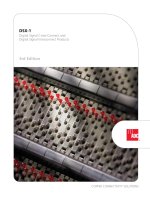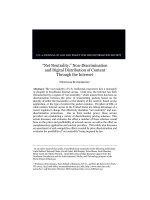Computers and digital basic computer concepts 2014 chapter07
Bạn đang xem bản rút gọn của tài liệu. Xem và tải ngay bản đầy đủ của tài liệu tại đây (3.41 MB, 58 trang )
Chapter 7
The Web and E-mail
Computer Concepts 2014
7
Chapter Contents
Section A: Web Technology
Section B: Search Engines
Section C: E-commerce
Section D: E-mail
Section E: Web and E-mail Security
Chapter 7: The Web and E-mail
2
7
FastPoll True/False Questions
Answer A for True and B for False
070100 is an example of a URL.
070200 The Web uses WEP as its main protocol
070300 If your browser can’t open PDF files, you can download the Adobe Reader plugin.
070400 The Web uses cookies because HTTP is stateless.
070500 [/ left] is an example of an HTML tag.
Chapter 7: The Web and E-mail
3
7
FastPoll True/False Questions
Answer A for True and B for False
070600 A Web designer who wants to create interactive pages can use scripts,
JavasScript and HTML5.
070700 A Web crawler is type of virus that affects cookies.
070800 Keyword stuffing is a technique for collecting user IDs from Web site logins.
070900 Most e-commerce shopping carts use cookies to keep track of the items you are
purchasing.
Chapter 7: The Web and E-mail
4
7
FastPoll True/False Questions
Answer A for True and B for False
071000 Secure connections typically begin with https.
071100 POP, IMAP, and SMTP are Web page protocols.
071200 E-mail attachments are converted with MIME into ASCII code.
071300 Blocking third-party cookies helps eliminate Web bugs.
Chapter 7: The Web and E-mail
5
7
Section A: Web Technology
Web Basics
HTML
HTTP
Web Browsers
Cookies
Web Page Authoring
Interactive Web Pages
Chapter 7: The Web and E-mail
6
7
Question
072100 The Web requires many technologies. Which one of the following statements is accurate about
these technologies?
A.
HTML, XHTML, and Ajax extend basic Web scripts so that Web designers can create pages
with videos and interactive questions.
B. Explorer, Safari, Firefox, and Chrome are examples of Web browsers.
C. Cookies and HTML codes are stateless Web protocols.
D. Text editors like ActiveX and Notepad can be used to create HTML documents.
Chapter 7: The Web and E-mail
7
7
Web Basics
The Web is a collection of document, image,
video, and sound files
Web 2.0
Web 3.0
A Web site contains a collection of related
information
Chapter 7: The Web and E-mail
8
7
Web Basics
A Web server accepts requests from browsers
A Web page is the product or output of one or more Web-based files displayed in a format
similar to a page in a book
A Web browser is client software that displays Web page elements and handles links
between pages
Every Web page has a unique address called a URL
Chapter 7: The Web and E-mail
9
7
HTML
Set of specifications for creating documents that a browser can display as a Web page
Markup language
HTML tags
HTML 5
XHTML
Source document
Chapter 7: The Web and E-mail
10
7
HTML
Chapter 7: The Web and E-mail
11
7
HTTP
Chapter 7: The Web and E-mail
12
7
Web Browsers
Popular browsers:
Mozilla Firefox
Microsoft Internet Explorer
Apple Safari
Google Chrome
It is a good idea to upgrade when a new
version of your browser becomes
available
Chapter 7: The Web and E-mail
13
7
Web Browsers
If your browser does not have built-in support
for a file format required to display or play a
Web page element, you can download the
necessary software
A plug-in is a program that extends a browser’s
ability to work with file formats
Chapter 7: The Web and E-mail
14
7
Cookies
Small chunk of data generated by a Web server and stored in a text file on computer’s
hard disk
Fix problems caused by HTTP’s stateless protocol
Chapter 7: The Web and E-mail
15
7
Web Page Authoring
HTML conversion utility
Online Web page authoring tools
Web authoring software
Adobe Dreamweaver
Text editor
Chapter 7: The Web and E-mail
16
7
Interactive Web Pages
Interactive and dynamic Web sites are possible when programming and scripting
technologies supplement native HTML features
An HTML form uses the <form> tag to accept typed input
Client-side and server-side processes
A computer scripting language called JavaScript is commonly used to add logic and other
programmable elements to a Web page
Chapter 7: The Web and E-mail
17
7
Interactive Web Pages
Chapter 7: The Web and E-mail
18
7
Section B: Search Engines
Search Engine Basics
Formulating Searches
Citing Web-based Source Material
Chapter 7: The Web and E-mail
19
7
Question
072200 Search engines are a key Web technology. When you use a search engine, you
can be confident that:
A. Your searches will remain confidential.
B. Information accessed by a search engine is in the public domain.
C. Search engine results are totally impartial.
D. You can usually narrow a search by adding more key words.
Chapter 7: The Web and E-mail
20
7
Search Engine Basics
A Web search engine is a program designed to help people locate information on the
Web by formulating simple keyword queries
Chapter 7: The Web and E-mail
21
7
Search Engine Basics
A Web crawler is a computer program that is automated to methodically visit Web sites
A search engine indexer is software that pulls keywords from a Web page and stores them in an index
database
A search engine’s query processor looks for your search terms in search engine’s indexed database and
returns a list of relevant Web sites
Link popularity is measured by quality and quantity of links from one Web page to others
A meta keyword is entered into a header section of a Web page when it is created and is supposed to
describe the page contents
Keyword stuffing
Chapter 7: The Web and E-mail
22
7
Formulating Searches
Most search engines work with keyword queries in which you enter one or more
words, called search terms
Chapter 7: The Web and E-mail
23
7
Formulating Searches
A search operator is a word or symbol
that describes a relationship between
search terms and thereby helps you
create a more focused query
Chapter 7: The Web and E-mail
24
7
Using Web-Based Source Material
Chapter 7: The Web and E-mail
25









